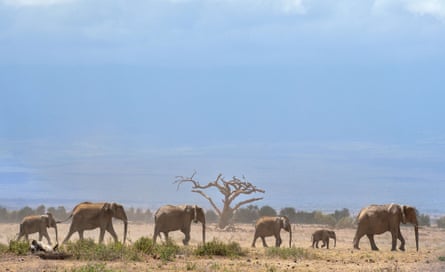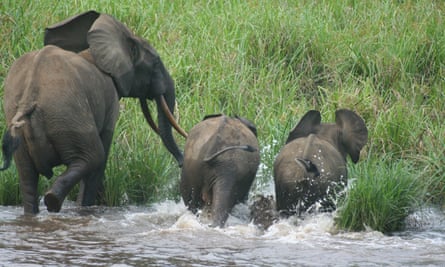The first ever “red list” assessment of the African elephant as two separate species – the forest elephant and savanna elephant – has found that both are threatened with extinction, according to an updated review of the world’s most at-risk plants and animals.
Poaching and the “silent killer” of human-driven habitat loss have caused sharp declines, with forest elephant numbers falling by 86% in the past 31 years and savanna elephants by about 60% in the past half-century.
The International Union for the Conservation of Nature (IUCN), which compiles a regularly updated “red list” of at-risk plants and animals, has opted to assess the African mammal as two separate species following genetic studies of populations, which have found that the forest and savanna elephants split from each other 5–6m years ago, at about the same time humans separated from chimpanzees.

The forest elephant has been classified by the IUCN as critically endangered, while the savanna elephant is listed as endangered. The African elephant had previously been categorised as vulnerable. Endangered and critically endangered are the lowest categories on the IUCN red list before a species is declared extinct in the wild.
Experts cautioned that while sub-populations of both species were thriving, the climate crisis, demand for ivory and the expansion of agriculture were persistent threats that were jeopardising their long-term survival.
Dr Kathleen Gobush, an elephant specialist who led a team of six IUCN assessors for the new classifications, told the Guardian: “Going from vulnerable to endangered and critically endangered shows a much higher risk of extinction. It doesn’t mean they’ll go extinct tomorrow but it’s a higher risk.
“This reclassification allows dedicated attention to each animal – the forest elephant and the savanna elephant – and then to tailor conservation plans according to each species’ needs, which are different.”
The most up-to-date survey from 2016 found that about 415,000 forest and savanna elephants remain on the continent. The majority of critically endangered forest elephants are in the Congo basin in Gabon, west Africa, while Botswana has the largest population of savanna elephants.
The new classifications could have significant consequences in conservation, science and politics as experts warn the forest elephant is understudied, with the savanna elephant dominating previous studies about African elephants. Leading international conservation bodies such as Cites, which regulates the international trade in endangered species, does not recognise the two types of African elephants as separate species.

Dr Ben Okita-Ouma, co-chair of the IUCN elephant group and head of monitoring for Save the Elephants, said: “As much as we may see that poaching has gone down in many countries, there is this silent killer of habitat fragmentation and habitat loss. During encroaching on elephant habitats, there are conflicts between elephants and people. In the process, elephants are killed.
“It is something that we need to really, really talk about. If you look at the data on the killing of elephants, we’re seeing a recent shift in terms of killing because of conflict instead of poaching.”
The change to the conservation status of African elephants is the most high-profile example of so-called cryptic species that appear similar to the human eye but are, in fact, separate and more than one.
Quick GuideCryptic species
Show
What are they?
For centuries, humanity has classified life on Earth largely based on its appearance. But genetic analysis of growing numbers of plants, animals and other organisms are finding thousands of so-called cryptic species that appear similar to the human eye but are, in fact, separate.
DNA analysis is routinely finding that similar looking organisms have significant genetic distance between them and should be classified as a species in their own right. Although there remains intense disagreement among biologists about what counts as a species, thousands of discoveries have been made.
What does it mean for life on Earth?
In 2020, the discovery of new species of aloe, African leaf-nosed bats and chameleons that were previously misclassified have thrilled conservationists. Scientists say our planet might be more biologically diverse than previously thought and estimates for the total number of species could be far higher than the current best guess of 8.7 million.
But it is not always good news. Cryptic discoveries often mean that species once considered common and widespread are actually several, some of which may be endangered and require immediate protection. For example, the newly described Popa langur in Myanmar, previously confused with another species, numbers about 200 and is likely to be classified as critically endangered, threatened by habitat loss and deforestation.
Should we expect more cryptic species to be identified?
Yes. It is cheaper and easier to perform genetic analysis on wildlife than ever before and scientists have said we should expect more “unmaskings”. Large mammals such as elephants, giraffes and primates have already been the subject of major discoveries but analysis of more diverse organisms – especially insects – is expected to show more cryptic species.
Forest elephants are generally smaller in size, have oval-shaped ears, straighter tusks and longer gestation periods, while savanna elephants live in larger family groups, have bigger ears and different-shaped skulls, among other differences.

The habitat range of both species rarely crosses over in Africa, with savanna elephants preferring grasslands and deserts, while the forest elephant is mainly found in tropical rainforests.
But examples of breeding between forest and savanna elephants – known as hybridisation – had caused scientific disagreement over classifying the animals as separate species despite strong genetic indications that they were different.
A study commissioned by the IUCN of areas where forest and savanna elephants interact found limited evidence of hybridisation, prompting the organisation to make separate red list assessments for the first time.
Alfred Roca, a population genetic specialist at the University of Illinois who has published key studies on the differences between forest and savanna elephants, welcomed the move by the IUCN but said it had been a long time coming.

He had previously warned that not recognising the forest elephant as a separate species could be condemning it to extinction.
“I would hope that it would mean more attention is paid to the forest elephants. Forest and savanna elephants probably have a bigger separation than lions and tigers. They’re also responsible for the germination and the dispersal of plants in tropical forest as they eat a lot of fruit and seeds. Losing it would be a huge loss,” he said.
Writing in the Guardian, Gabon’s minister for water and forestry, Prof Lee White, said he could not imagine a world without elephants. Gabon is home to the majority of critically endangered forest elephants.
“We need urgently to harness this great love of elephants to the task of finding socially equitable solutions for their conservation. The future of both the forest and savanna elephants will be decided in the hearts of people in both developed and developing countries,” he writes.
Find more age of extinction coverage here, and follow biodiversity reporters Phoebe Weston and Patrick Greenfield on Twitter for all the latest news and features
